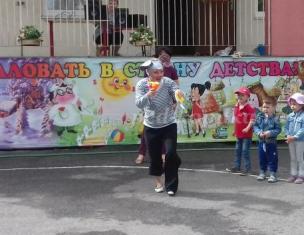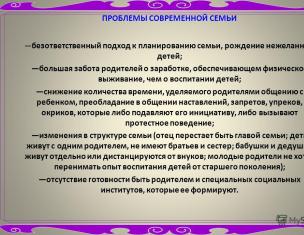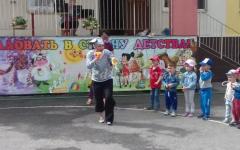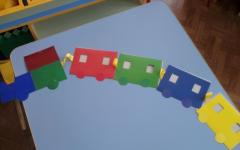Great day - honoring YARILA (Yaruna, Yarovita) - the God of the spring Sun, male strength, militancy, yari, and courage.
Yarila also carries military qualities, which are simultaneously intertwined with the image of God the protector. Consequently, the Great Day of Dazhbozhy is a celebration of the birth of the Bright Spring Sun-Yarila. The tradition of holding the holiday necessarily included valiant fun so that men could awaken and increase the amount of Yara force, i.e. male, military strength, increase courage.
The traditional valiant fun on Velikden - Maslenitsa was fisticuffs.
Fist fighting, as a martial art (and at times folk fun), was a fight with bare fists. In Rus', fisticuffs were not only entertaining in nature, but were also aimed at developing military skills among the masses of the population, which were used to protect their lands and other military actions.
The fistfight was not at all a massacre without rules, it was a whole rite, a tradition that was revered by the people, and the strongest fighters enjoyed universal fame and respect. “Kulachki”, “Boyovishche”, “Navkulachki”, “Boyka” - words that today have gone out of common use, previously meant just a fistfight.
Rules and types of fisticuffs.
Fisticuffs were held in different versions: “wall to wall”, “street to street”, “village to village”, “settlement to settlement”. In the summer, the battle took place on the squares, in the winter - on frozen rivers and lakes. Both ordinary people and merchants participated in the battles.
The most ancient type of combat is considered to be the “clutch-dump”, which was often called “coupling fight”, “scattered dump”, “dump fight”, “coupling fight”. It was a confrontation between fighters who fought without observing the order, each for himself and against everyone. As N. Razin mentioned: “Here it was necessary to have not only dexterity and a strong blow, but also special composure.”
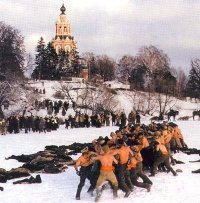
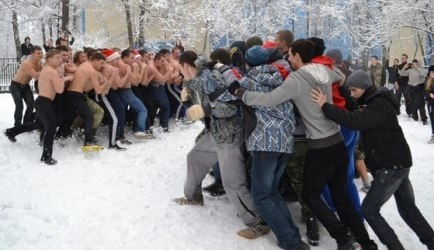
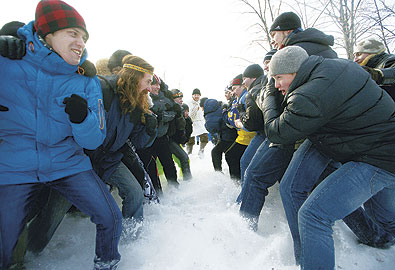
The most common type of fisticuffs was "wall to wall". The battle was divided into three stages: at first the boys fought, after them - unmarried young men, and at the end, adult men also put up a wall. It was strictly forbidden to beat a lying or crouched person, as well as to grab clothes. The task of each side was to put the enemy side to flight, or at least force them to retreat. The wall that lost the "field" (the territory on which the battle was fought) was considered defeated.
Each "wall" had its own leader - "leader", "ataman", "fighting headman", "leader", "old man", who determined the tactics of battle and encouraged his comrades. Each of the teams also had "hope" fighters, who were intended to break the enemy's formation, pulling out several fighters from there at once. A special tactic was used against such warriors: the wall diverged, letting “hope” inside, where special fighters were waiting for him, and immediately closed, preventing the enemy’s wall from passing. The warriors who met "hope" were experienced masters of "one-on-one" combat.
Valiant fun "Hats".
Two guys play this traditional game. Each of them has a hat on their head. By mutual readiness, the players begin, sometimes marking the beginning with some action, for example, “pile”. The task is to use your dexterity and resourcefulness, using various tricks and feints, to knock the hat off the opponent's head. There are variants of the game when the hat can not only be knocked down with a blow like a slap in the face, slap, etc., but also torn off. A hat falling to the ground is a sign of victory.
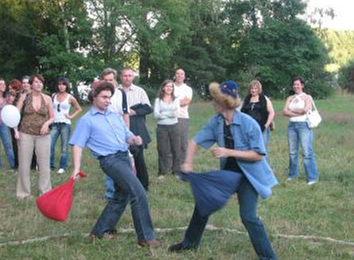
In general terms, apart from the various variations of this game, the rules are as follows:
- hit the hat.
- hit with an open hand.
- during the competition, do not hold your hat and do not straighten it with your hands.
- the winner is the one who remained in the hat.
The game "Tugging with feet."
Opponents stand on one leg sideways to each other, grappling with the feet of raised legs. Everyone tries to force the opponent to stand on both feet. The one who cannot stand on one leg loses. At the same time, you can’t push the opponent with your hands, it is advisable to lay them behind your back.
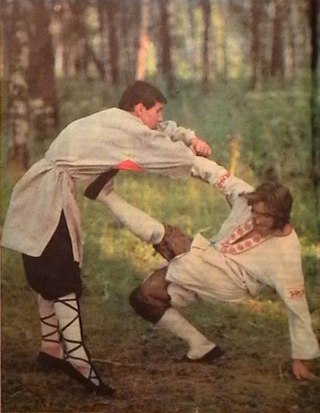
The game "Who will remain in the circle"?
Standing on one leg and crossing their arms over their chest, the participants try to push each other out of the circle with their shoulders or force them to stand on both legs. Whoever fails to resist is out of the game.
The finale is especially interesting when the two strongest and most dexterous participants remain in the circle.
On holidays, other folk games and round dances are also held.
Round dance "In the garden, in the garden."
Participants go to the right in a circle, holding hands, standing in turn: well done, young lady and sing the words of the song:
« Whether in the garden, in the garden
The girl was walking
She has blond hair
The ribbon is blue.
Uh, uh, uh-huh- (everyone goes in a circle, well done, at the end of the words they stamp their feet, while the young ladies pull the young ladies into the circle with a little force, and the young ladies slightly rest).
". - (Everyone goes from the circle, the young ladies say) .... - 2 times.
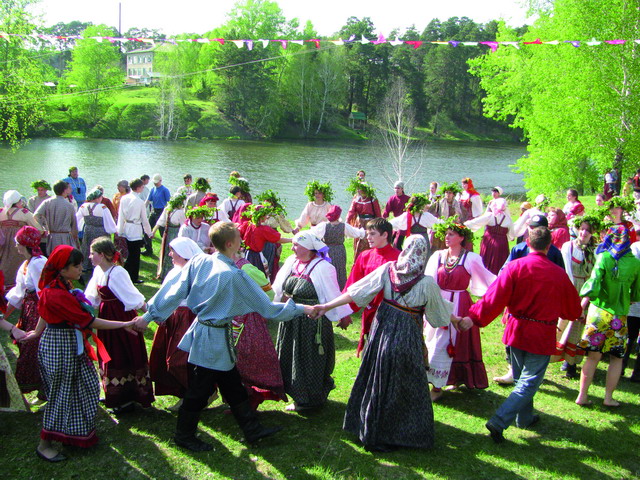
Participants go left in a circle, holding hands and sing further:
« Whether in the garden, in the garden
The girl was walking
She is small in stature
Round face.
Uh, uh, uh-huh- (everyone goes in a circle, they say well done, at the end of the words they stamp their feet).
What are you, what are you, what are you, what are you". - (Everyone walks out of the circle, the young ladies say) .... - 2 times.
Well done, when pronouncing the words: “Wow, wow, wow - ha,” show male ardent strength in your voice and behavior.
Young ladies need to say the words: “What are you, what are you, what are you, what are you - in a thin, soft voice and show female shyness in behavior.
The game "Brook".
This game was known and loved by our great-grandmothers and great-grandfathers, and it has come down to us almost unchanged. There is no need to be strong, agile or fast. This game is of a different kind - emotional, it creates a mood, cheerful and cheerful. The rules are simple. The players stand one after another in pairs, usually a boy and a girl, a boy and a girl, join hands and hold them high above their heads. From clasped hands, a long corridor is obtained.
The player who did not get a pair goes to the “source” of the stream and, passing under clasped hands, looks for a pair for himself and takes the chosen girl with him. Holding hands, the new couple makes their way to the end of the corridor, and the one whose pair was broken goes to the beginning of the "brook". Passing under clasped hands, he takes with him the one he likes. This is how the “stream” moves - the more participants, the more fun the game is, it is especially fun to play it to the music.
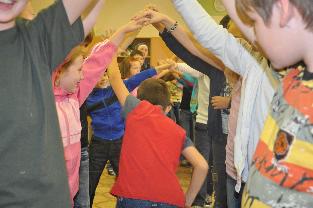
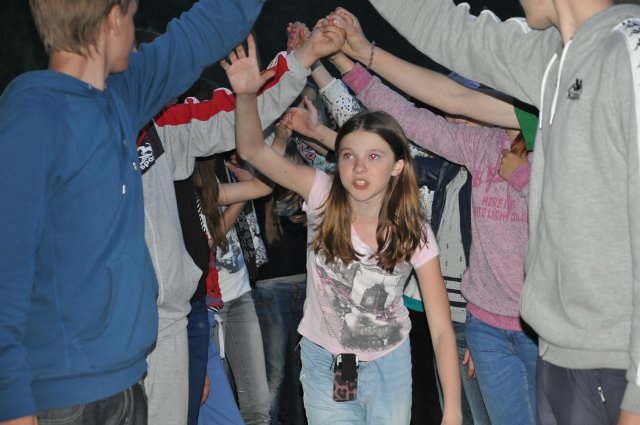
Not a single holiday in the old days was complete for young people without this game. Here you have a fight for your beloved, and jealousy, and a test of feelings, and a magical touch on the chosen hand. The game is wonderful, wise and extremely meaningful.
Golden Gate.
Of the 6-20 participants in the game, two stronger ones are chosen. They step aside a little and agree which of them will be the Sun and which will be the Moon (Moon). Those who have chosen the roles of the sun and the moon become facing each other, join hands and raise them, as if forming a gate. The rest of the players, holding hands, go through the “gate” in a string. While singing your favorite songs.
When the last one goes through the gate, they “close”: the Sun and the Moon lower their raised hands and the one who walked last is between them. The detainee is quietly asked where he would like to be, behind the moon or the sun. Then, all the players again go through the "gate", and again the last one is stopped. This is repeated until everyone is divided into groups. Then the groups arrange a tug-of-war, holding hands or using a rope, stick, etc.
The game "Nevod".
The game takes place on a limited area, the limits of which cannot be crossed by any of the players. Two or three players hold hands, forming a "net". Their task is to catch as many “swimming fish” as possible, i.e. the rest of the players. The task of the "fish" is not to get caught in the "net". If the "fish" could not evade and ended up in the "net", then it joins the drivers and itself becomes part of the "net". "Fish" do not have the right to tear the "net", i.e. disengage the hands of the leaders. The game continues until the player who turned out to be the most "agile fish" is determined.
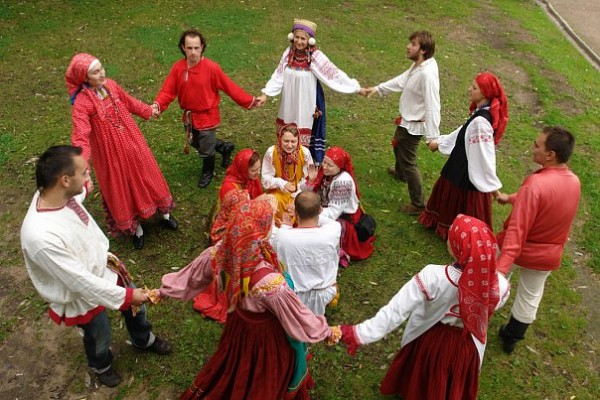
The game "Guide".
In the inner circle, facing the center of the circle, men stand, hold hands and close their eyes. In the outer circle, girls dance in a round dance to the music. After some time, at the signal of the leader - a clap or a whistle, the girls begin to disassemble the guys - any of those they like that are closer. They take the guy by the hand and lead him in a circle, the guy walks all this time with his eyes closed. It is desirable that the number of girls and boys match so that no one is left standing alone in the inner circle.
At the signal of the leader, the girls carefully line up the guys again in the inner circle, and they themselves go further in a round dance. This is repeated three times. When, after the third time, the guys are again placed in the inner circle, the leader gives a signal: “You can open your eyes.” The "showdown" begins. The guys describe their feelings, name which of the three girls they liked, whom they would like to see. Girls are usually happy to confess and show themselves. Further, girls stand in the inner circle with their eyes closed, and the guys stand in the outer circle and everything repeats.
Handkerchief game.
Everyone is standing in a circle. The leader comes out and throws up one or more small handkerchiefs, depending on the number of people. The task of the guys is to catch the handkerchief. If at least one of the handkerchiefs fell to the ground, a symbolic “punishment” is assigned to the guys who did not catch, for example, to do 10 push-ups. Further, those who caught the handkerchief come up to the girl they like and invite her - they put the handkerchief on her shoulder.
Then, to the music in the dance, the guy must take the handkerchief from the girl without using force, and the girl, also in the dance, must dodge and prevent the handkerchief from being taken. Note: This is a folk game and it is played to folk music. The music continues until all the guys in all pairs take away the handkerchiefs. If the guy took the handkerchief before the others, he dances with the girl, holding on to the handkerchief until the end of the music.
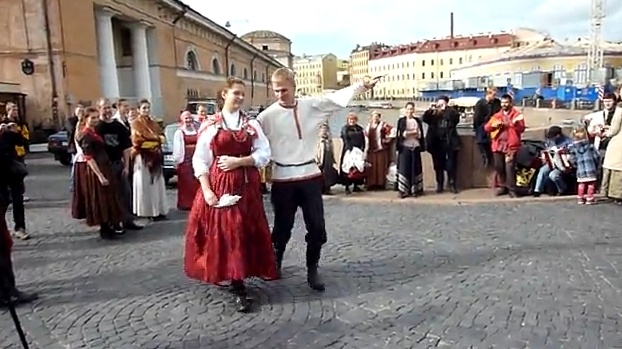
Then, one person throws all the handkerchiefs up again. Remember that in the dance you demonstrate grace, become, dexterity and ease. A guy just trying to corner a girl, or acting like an opponent in a sports ring, looks just as ridiculous and ridiculous as a girl trying to save a handkerchief by hiding it in her fists or wrapping knots around her fingers.
Hot numbers game.
The guys sit down. Girls sit on their knees. One guy without a partner. The host passes and says in the ear of each girl her number according to the number of girls. Then, he begins to spank his “empty” knees with a belt or a whip. The guy should shout out the number, the girl whose number is called runs and sits on his knees, protecting him from the strap. The host rushes to the "empty" knees, the guy shouts the number and so on.
A very fun moving game. Also, during the game, in order to confuse the one with the belt, those sitting next to each other can negotiate and change numbers! And then, after some time, the leader with the belt manages to learn all the numbers and reacts very quickly.
The game "Start up".
Children from 7 years old and young people participate in this game. The most convenient number of participants is from 10 to 20 people (if the number is more than 30 or less than 5, it is already difficult to play). The game does not require a lot of space. The rules of the game are:
The players form a circle facing the center. The driver (usually called at will) steps aside or closes his eyes, as he should not see who will be chosen as the ringleader (entertainer). The task of the ringleader is to show various movements, which, immediately, keeping up with him, should be repeated by the rest of the players: clap, squat, jump, threaten someone with a finger, etc.
The driver is called into the circle, and he begins to walk inside it, looking closely at who “starts” a new movement each time. After three movements have changed with him, the driver must guess the ringleader, but he tries to change the movements imperceptibly, choosing the moment when the driver does not look at him.
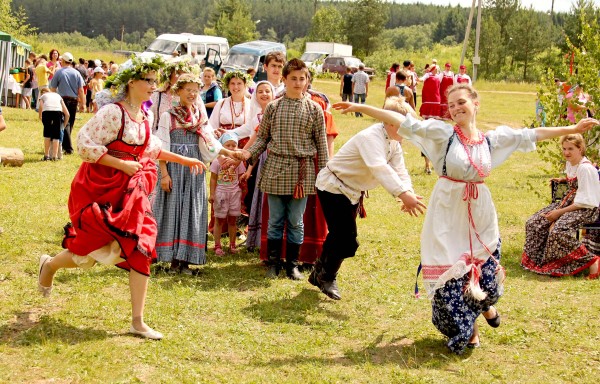
If the driver mistakenly calls any participant a ringleader, the game continues. But after three mistakes, the driver leaves the circle, and at this time they choose a new ringleader (or they can, if desired, leave the previous one). If the driver guessed the ringleader, then he changes role with him. Rule: the driver is not allowed to look for a long time, without looking up, at one of the players (the alleged ringleader), he must turn in different directions.
Round dance "Kiss, girl, well done."
The game will require 8 or more participants (the more the better). Girls stand in the inner circle, guys stand in the outer circle. Then, everyone starts to move: the girls rotate Kolovrat (counterclockwise), and the guys - salting (clockwise). Everyone sings:
Matryoshka walked along the path,
Lost two earrings
Two earrings, two rings,
Kiss, girl, well done.
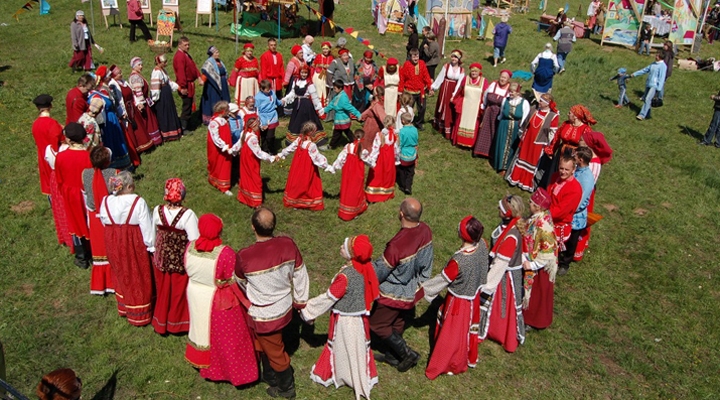
With the last words, everyone stops. Those guys who were opposite, the girls - kiss! After that, everyone sings:
Matryoshka walked along the path,
Lost two earrings
Two earrings, five rings,
Kiss the girl, well done.
With the last words, everyone stops. Those girls who were opposite, the guys - kiss!
Turnip game.
Depicting a turnip (it is chosen, for example, with the help of a rhyme) clings tightly to an immovable object: a tree, a stump, a pole. The rest wrap their arms around each other's waists. One of the players is trying to "pull out the turnip", i.e., pull the player representing the turnip away from the tree. If the players succeed, then they all lose their balance and fall to the ground, only the most dexterous participants in the fun can stay on their feet. If the row is broken, and the turnip is not pulled out, everyone laughs: “We didn’t eat the turnips.”
Instructions for the game Turnip: the minimum number of participants is 4 people. It is good to play this game in the forest during a walk, choosing a convenient platform. After several attempts to "pull a turnip", which ended in failure, a new "turnip" is selected and all participants must be in this role. This game is interesting for preschool children.
Game "Radish".
The players stand one after another, clasping their hands in the form of a long ridge. The first is called "grandmother", all the rest are radishes. One of the players, chosen by lot, is called Ivashka Popov. He approaches the grandmother and talks to her: "Knock-knock." - "Who is here?" - "Ivashka Popov". - "Why did you come?" - "For a radish." - "Not in time, come tomorrow."
Ivashka Popov leaves, but soon returns. The conversation with the grandmother is repeated, but the ending changes - the grandmother replies: "Pull whatever you want." Ivashka pulls everyone in turn. Who pulled out more radish is the winner.
Instructions for the game Turnip: the game can have 4 or more participants in the game. Radishes try to hold each other tightly. Ivashka can shake the players - some by the hands, some by the head, etc. Laughing players are easier to "pull out".
Game "Drake and Duck".
Drake (guy) and Duck (girl) are selected. They stand in a circle. Initially, the duck is in the circle, the drake is behind the circle. A song is sung, you can just say:
Drake drove the duck,
Young sulfur drove
Let's go, duck, home,
Let's go, gray, home,
She has seven children
Eighth - drake,
And the ninth is herself,
Kiss me once.
A drake and a duck can run as they please, the circle can help or hinder them. This is a variation of the cat and mouse game. When the Drake catches up with the Duck, they stand in a circle and the players sing: “If you kiss, don’t play around anymore.” The guy kisses the girl.
The game "Golden Gate" (circular).
3-4 people of the game participants form a circle, facing the center and raising their closed hands. A chain of other players, holding hands, runs through these "gates". Standing players (gates) sing:
Golden Gate
Not always missed:
Saying goodbye for the first time
The second time is forbidden
And for the third time -
We won't miss you!
After the words “we won’t let you through,” those who form the “gate” lower their hands. Those who are inside the circle join hands with those forming the circle, increasing the number of "gates". Those who are not caught, restore the chain and run again. With each closing of the gates, there are fewer and fewer runners. The three players not caught in the game are declared the winners.
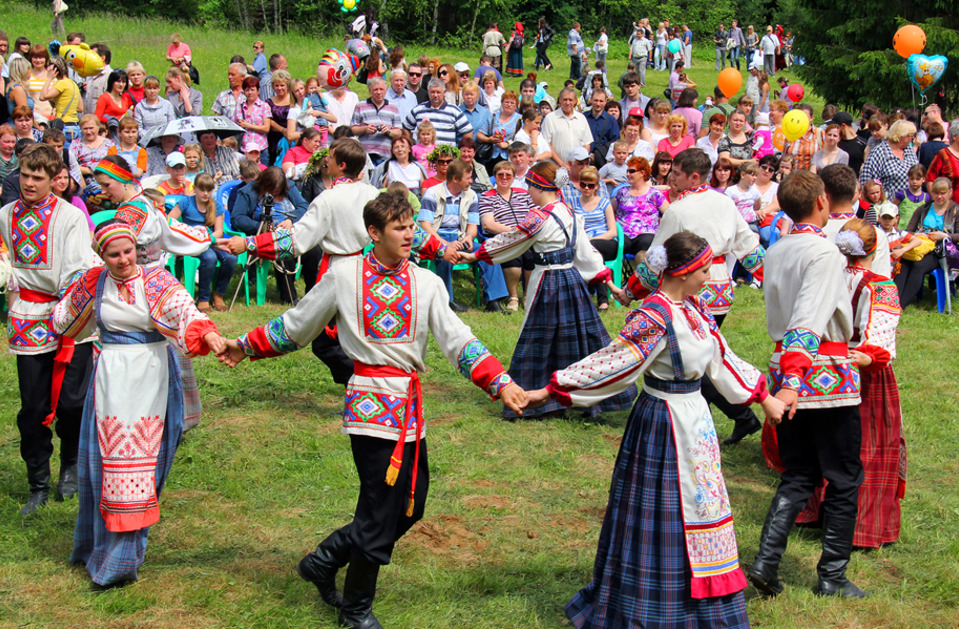
- A player who must pass through the gate must not stop in front of it (for fear that it will close). Stopped considered caught.
- Walking or running people should not unhook their hands. You have to hold hands with at least one player. Whoever runs without holding hands with anyone is considered to be caught.
- You can lower your hands (“close the gate”) only at the last word of the song. Those caught early must be released.
- To avoid injury (remember that people do not have cast-iron heads), lower your arms gently.
Fanta game.
First you need to collect forfeits from all those present. It can be a piece of clothing or jewelry, a piece of paper with a name or any other item. The main requirement for a phantom is that it be small and that it is possible to accurately determine which of those present is its owner. As a rule, collecting forfeits turns into an independent game. The simplest option is to take one phantom from each of those present.
Leaders are two. One takes out forfeits, shows them to everyone except the second presenter and asks: “What should this fanta do”? The second host gives the task - to sing, dance, crow, go outside and run around the house, go to the next room and bring sweets, wash the dishes. The range depends on the imagination and on the previously agreed scope of the tasks performed.
Game "Dawn".
Children playing the game stand in a circle. At the same time, the hands are held behind the back, and one of the players, whose name is “dawn”, needs to walk behind with a ribbon and say:
"Dawn - lightning,
red maiden,
Walked across the field
Dropped the keys
golden keys,
blue ribbons,
entwined rings -
Went for water!
When pronouncing the last words, the driver carefully places the tape on the shoulder of one of the players. The one to whom he put the tape quickly takes it, and they both run in different directions in a circle. It is necessary to take a free place, and the one who remains without a place becomes the “dawn”. The game with such rules is repeated over and over again. Runners should never cross the circle. The players do not turn until the driver chooses who to put the tape on his shoulder.
Mail game.
The game begins with the roll call of the driver with the players:
- Ding, ding, ding!
- Who's there?
- Mail!
- Where?
- From the city …
- What are they doing in the city?
The driver during the game can say that they are dancing, singing, jumping in the city. Everyone playing the game must certainly do what the driver said. And the one who performs the task poorly gives the phantom (any item of the player) to the driver and the game ends as soon as the driver collects 5 phantoms. Participants whose forfeits are with the driver must redeem them, for which the driver comes up with interesting tasks for them that they must complete. Children read poems, tell funny stories, and also remember riddles, they can imitate the movements of animals. Then, a new driver is chosen again, and the game is repeated again.
The game "Give a handkerchief of sympathy."
Goals with an inclined crossbar are installed on the playing field. On it, colored handkerchiefs are hung on thin threads and at different heights. Competitors need to run up, jump up and tear off one of the handkerchiefs. Having taken possession of the handkerchief, you need to name the girl and give her your torn handkerchief.
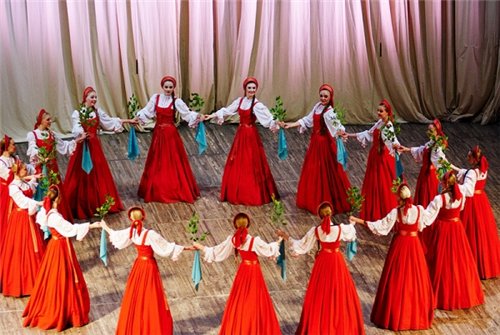
Fun called "Cock."
I.A. Morozov, I.S. Sleptsova - "Men's fun and entertainment in the Russian North" - an excerpt from the book.
Guys who want to test themselves sit on a wide bench facing each other, legs tucked in Turkish so that they do not touch the floor. One of the participants puts his palms together and presses them to his ear, and the second one beats his hands with a sweeping palm or fist. If the first guy was kept on the bench, then he struck the next blow, and if he fell, then another person who wanted to try his luck sat down in his place, and the second player continued to beat.
According to eyewitnesses, there were a lot of people who wanted such competitions, because everyone wanted to know “whose hand is brighter (i.e., sharper)”, but often it came to a serious fight due to some violation of the rules of the game.
This fun remained popular in the 20-30s of the 20th century. This is how guys and adult men had fun at gatherings and feasts. The differences were only in details. For example, in the village of Maslovo, they could fold their hands a little differently: one with the palm to the ear, and the other with the palm outward; that is, the blow was applied to the palm of the second hand.
In the village of Penduz, the competitors stood on the bench, and in the village. Levash and the village of Gavrilovskaya - on the floor or on the ground; in with. Lipin Bor, rivals, sitting astride a bench and tucking their legs, tried to knock each other to the floor with pillows, and in the village of Budrinskaya, the players sat astride a thick (12-15 cm) pole, crossed and tucked their legs. The ends of the pole were located on two benches installed in parallel.
Fighting dance in Russian tradition.
A combat dance is a single, pair or group form of self-expression with a rhythmic accent that determines the type and nature of the movement, which contains elements of combat training. There are two main varieties of Russian combat dance.
The first is a squat dance , a section of ordinary, traditional Russian male dance. This tradition prepares the fighter for combat while lying down, sitting and squatting. Special dance moves and moves in combat become strikes and defenses. They say that before this tradition was mandatory in the training of riders, along with the acrobatics of horse riding. A rider who fell from a horse, using the squat fighting technique, could escape from a saber strike, knock the enemy out of the saddle and take possession of his horse, slip under the belly of a walking horse, cutting its groin. In foot combat, it was used for fighting in the flea market and in case of falling to the ground.
Another variety of it is “breaking” or “buza”. This type of combat dance contains elements of standing hand-to-hand combat. Breaking is not at all like other sets of combat movements. Movements in breaking are not the execution of techniques without a partner. It is also not a combination of attacks and defenses.
The combat elements of breaking are rather the "embryos" of movements, which are at the same time the mother - a potential biomechanical model, from which, depending on the situation, blows, defenses, and throws grow, depending on the situation. These elements are called "knees"; their final number is unknown, it is likely that it has never been established, approximately there are from 7 to 15. These elements are combined in the dance spontaneously, strung on a common dynamic dance canvas.
However, this is not what distinguishes breaking from simple dancing. The breaking of the booze is the breaking of the rhythm in which the surrounding world moves. The buzzing fighter consciously dances, violating the rhythm of the dance and the harmony of the music with his movements, sings choruses to the fight, out of time and out of tune. Thus, he falls out of the general surrounding rhythm of the world, destroying the framework of his usual perception, and begins to see everything differently, as if from the outside.
In this dance, also, the “float” is best trained - a special Buzov state of perception. Against the background of the mischievous mood created by music and songs, by changing perception, the fighter trains spontaneously combined fighting movements. In this combination of trained qualities lies another value of breaking in the booze - wholeness is achieved.
I would like to emphasize that breaking the booze is not a trance state of consciousness because the dancer is in this real world, “here and now”, does not go to “other worlds”, does not communicate with spirits, like shamans and does not change consciousness, only his perception of the surrounding world. You can break both with weapons and without them.
In short, in the old days, the rite of breaking went something like this: an artel (50 people) gathered somewhere at a crossroads, on a bridge, on a hill, usually at night. At night because there was no time during the day. There, standing in a wide circle, they began to dance, replacing each other, to the accordion, tambourine, harp or balalaika. It happened that several instruments were playing at the same time.
After the dance, when the musicians had already begun to play the booze, they went out to break, first one at a time, then in pairs or groups. During the breaking, they began to push, trying to throw off the opponent’s push and, having outplayed, push himself, preferably so that the opponent fell.
After some time, one of the broken ones could not stand it and struck, so the stage began, which today would be called sparring. The fighters changed each other, left the circle and went out to break again. The whole procedure lasted for hours (three or four). Despite the sleepless night spent in dancing and fighting, in the morning everyone felt a surge of strength and, having slept for a couple of hours, went to work.
Buza is a martial art recreated in Tver by G. N. Bazlov in the 1990s. Includes combat dance, hand-to-hand combat, as well as combat with weapons.


